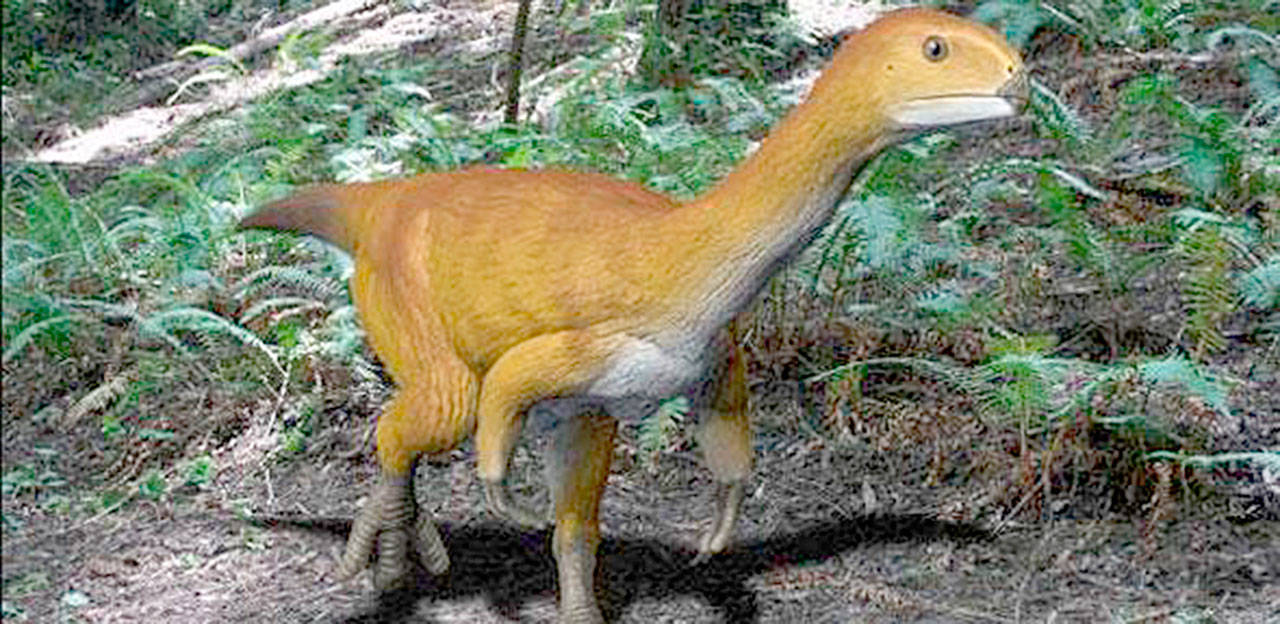By Amina Khan
Los Angeles Times
Chilesaurus, a two-legged dinosaur with a Frankenstein-like mix of features, could be the “missing link” that fills a mysterious gap in the dinosaur family tree, a new analysis shows.
The findings, published in the journal Biology Letters, may support a new proposal that could alter our understanding of dinosaur evolution.
Chilesaurus, described by an earlier team of scientists in 2015 in the journal Nature, lived around 150 million years ago in what is now southern Chile. About 7 to 10 feet in length from snout to tail, it walked on its back legs. Judging by its flat teeth, the dinosaur was probably an herbivore.
Scientists place dinosaurs into the family tree by comparing key physical characteristics, such as the teeth or the shape of the hips. Chilesaurus didn’t seem to fit neatly into any one of the dinosaur categories, said Matthew Baron, a doctoral candidate in paleontology at Cambridge University who co-led the Biology Letters paper.
Dinosaurs are generally separated into one of two groups: the “lizard-hipped” Saurischia, which includes theropods (like Tyrannosaurus rex and all birds) and Sauropodomorphs; or the “bird-hipped” Ornithischia, which counts stegosaurus, triceratops and the duck-billed hadrosaurs among its members.
Chilesaurus didn’t fit into any of these categories. It was classified as a theropod, which are mostly meat-eaters. Yet it had flat teeth for plant-eating, as the largely herbivorous Ornithischia would. Why would it have a mix of traits if those two groups were so distantly related?
“It was a bit of a puzzling specimen, really,” Baron said.
Earlier this year, however, Baron showed that the dinosaur family tree branches might need to be radically redrawn. And he did just that, putting theropods and ornithischians together as sister groups, with a direct shared ancestor. Under his new model, described in the journal Nature, Baron realized that this strange Chilesaurus fossil might actually make sense.
Baron reanalyzed the dinosaur’s features by comparing them against the 457 physical characteristics he’d already used to categorize dinosaurs for his updated family tree.
The results put Chilesaurus in with the plant-eating ornithischians, not the meat-eating theropods. And since those two groups are sisters in Baron’s proposed family tree, sharing a direct common ancestor, it makes sense that Chilesaurus is a transitional species, with some traits from both groups.
Baron speculated that the ancestor to theropods and ornithischians could have been omnivorous, and as its descendants split, one group became overwhelmingly carnivorous while the other turned increasingly to plants.
To eat more plants, ornithischians had to develop larger, more complex guts — and their hips shifted into the bird-like position the group is named for. But Chilesaurus doesn’t seem to have the bony beak of many of its peers, such as triceratops.
This was a bit of a surprise — previously, scientists weren’t sure whether the plant-cropping beak or the plant-digesting gut developed first in these herbivores, Baron said. Chilesaurus provides a possible answer to that question.
(Keep in mind, even though ornithischians are called “bird-hipped,” living birds are actually descended from the “lizard-hipped” theropods, not from ornithischians. Scientists came up with these labels in the late 1880s, long before researchers knew about the relationship between dinosaurs and birds, and the names stuck.)
Sorting out these differences is important because it helps us understand the complex and dynamic relationship between animal evolution and the environment, Baron pointed out.
Around 200 million years ago, the supercontinent known as Pangaea began to break up and the fragments drifted apart, eventually becoming the continents we recognize today. That allowed more moisture to reach more land, allowing plants to flourish and spread. And as plants thrived, the thinking goes, so did plant-eating dinosaurs, developing and diversifying like never before.
“Dinosaurs really are the best model set of organisms that we have for looking at larger questions about life on earth because they’re very well studied,” Baron said. “We have a 247-million-year record; we know a lot about how they lived and changed and adapted through time.”
And dinosaurs lived though some of the most turbulent changes in Earth’s history, he pointed out — dramatic shifts in temperature, sea level and atmospheric content. All those changes, preserved in rock, can be mapped against the fossil record to see how life reacted and adapted over time.
“As well as being really cool museum specimens and movie monsters,” Baron said, “dinosaurs are also one of the best groups of organisms that we know of for modeling how life responds to a changing climate.”


